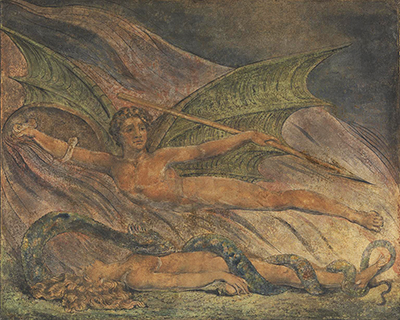Satan Exulting over Eve is a watercolour designed over a colour print, with the use of black ink and pen, as well as graphite. It is a colour print mounted on canvas created based on a symbolistic style, and the genre is religious. William Blake designed it in 1795.
Illustration
Blake's pictures mirrored his very own personal visualisations, which he claimed were not a hazy mist of nothingness. He insisted that they are ordered and microscopically defined above anything that corporeal and perishing nature can give. His twelve huge, colour-printed canvases from 1795 are among his most intricate works. To accomplish the desired results, poet-painter Blake devised a novel three-step process:
Sketching the picture on stiff paper board using thick, sticky watercolours.
Impressing the sticky doppelgänger on paper.
Painting over the resultant print with pen, ink, and watercolour washes.
There are only three variations of each photograph known to exist, each one inimitable.
Influence
Blake's Satan displays no signs of depravity or bestiality, as one might anticipate. Milton's Paradise Lost, in which Satan is portrayed as a sublimely heroic character, influenced several 18th-century painters. Satan's wicked essence may be seen condensed in the shape of the serpent in Blake's painting. Lavater's interpretation of this monster was based on orthodox Christian thought, but his depiction was based on the contradictory concept of the reptile's lack of form.
Technique
Satan looms above Eve, who is entangled by his alter self-image, the snake of the Garden of Eden. The opaque, fibrous, uneven hue of the earth under Eve indicates that it is printed. Still, the uniform sweep of the reddish washes indicates that the flames beyond Satan are largely watercolour. This is a technique William Blake frequently employed because he loved its transparency.
While the main pigments in the painting are earth colours of brown and green hues, there are tints of other brighter colours like hints of red and yellow. The background at the top is dark, depicting Satan's evilness. The way Eve is lying on the ground almost seems motionless, with the serpent engulfing her presence. With his dark green wings and intimidating arrow, Satan hovers his presence over her in a dominating manner. The serpent intertwines Eve's legs, restricting her movement and holding her hostage.
Location
It was acquired in 1996 with the help of the Essick Foundation, the Friends of the Tate Gallery, the National Heritage Memorial Fund, Edwin C. Cohen, and other philanthropists to honour Martin Butlin, the Keeper of the British Collection 1967 to 1989.




